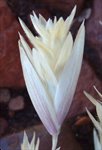
T. basedowii spikelet.
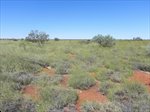
T. basedowii habitat.
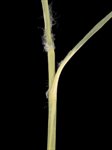
T. basedowii sheath and orifice.
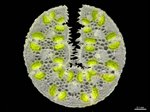
T. basedowii leaf section.
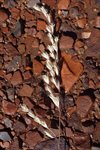
T. basedowii inflorescence.
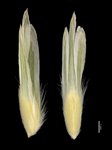
T. basedowii lemmas.
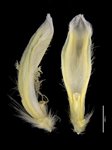
T. basedowii paleas.
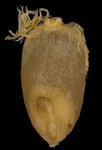
T. basedowii caryopsis.

T. basedowii map.
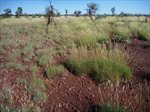
T basedowii (right, green) and T.vanleeuwenii (left, blue-green) plant comparison.
Name
Triodia basedowii E.PritzCitation
Repert. Spec. Nov. Regni Veg. Beih. 15: 356 (1918)Derivation
Repert. Spec. Nov. Regni Veg. Beih. 15: 356 (1918)Common name
Lobed Spinifex
Synonyms
None
Diagnostic features
Foliage non-resinous; leaf sheath surfaces lacking hairs or (outside the Pilbara) sometimes woolly; orifice with woolly hairs, the hairs extending onto the leaf blade; leaf blades amphistomatous (hard-type), longest leaves usually >15 cm long; inflorescence a branched panicle; lower glume with (5–)7–12(–15) nerves; lemmas deeply 3-lobed, not awned, bitextured; lemma midlobe (3.2–)3.5–5.5(–7) mm long; lemma body with hairs all over surface; callus (0.2–)0.5–1 mm long; palea glabrous or hairy; habitat on red sand or sandy loam flats; distribution mostly east or south of the Pilbara, or along the Fortescue Valley
Habitat
Sand and sandy loam flats
Distribution and frequency
Occurs throughout most of the inland deserts of Australia, east to the Simpson Desert in Queensland, and in the west reaching the southern and eastern margins of the Pilbara bioregion. Extends into the Pilbara proper along the southern Fortescue Valley. Forms extensive monocultures in the Great Sandy and Little Sandy Deserts
Similar species
Triodia basedowii belongs to the Basedowii group, sharing the group features of non-resinous foliage, amphistomatous (hard-type) leaf blades, many-nerved (≥6) glumes and un-awned lemmas. Similar to several other species of the Basedowii group, in particular T. chichesterensis, T. glabra, T. lanigera, T. scintillans and T. vanleeuwenii.
In T. basedowii the leaves are longer (longest leaves usually >15 cm long) and orifice hairs extend along the upper surface of the base of the leaf blade, while in T. chichesterensis, T. scintillans, and T. vanleeuwenii the longest leaves are usually <10 cm long, and the orifice hairs do not extend onto the leaf blade. Triodia basedowii also has more [(10–)13–54] spikelets per inflorescence than T. scintillans and T. vanleeuwenii [7–19 and 5–9(–14) spikelets per inflorescence respectively] and lacks sparkling droplets on new sheaths found in the latter two species.
The orifice of Triodia glabra lacks hairs or is very shortly hairy (woolly in T. basedowii). Triodia lanigera has a longer callus 0.8–1.5(–1.8) mm long, compared to (0.2–)0.5–1.0 mm long in T. basedowii, and often has a longer lemma midlobe (4.2–11 mm) compared to T. basedowii which is (3.2–)3.5–5.5(–7) mm long. Triodia chichesterensis, T. glabra and T. lanigera do not overlap in distribution with T. basedowii. Where T. lanigera and T. basedowii occur in close proximity north of Munjina (Auski), T. lanigera either has woolly leaf sheaths OR occurs on rocky to gravelly soils on the Chichester plateau, while T. basedowii is restricted to the plains of the Fortescue Valley, and in that area always has glabrous leaf sheaths (can be woolly outside of the Pilbara bioregion).
Triodia birriliburu has lemma lobes free for less than 1/3 of the total lemma length and shortly hairy orifices, whereas in T. basedowii the lobes make up at least 1/2 of the total lemma length and the leaf orifices are woolly.
Triodia infesta, T. mallota and T. plurinervata have unbranched inflorescences (clearly branched in T. basedowii).Conservation status
Not considered at risk.
Identification without florets
The features outlined under Similar species serve equally well for specimens lacking florets. Triodia lanigera is difficult to distinguish from T. basedowii when florets are absent, but can be distinguished by distribution.
Triodia birriliburu can be distinguished from co-occurring T. basedowii by having glabrous sheaths and shortly hairy orifices (orifices and often sheaths woolly in T. basedowii), and occurring on or immediately adjacent to dunes (usually in swales between dunes in T. basedowii).Variation
A variable species thought its range in inland Australia (see Anderson 2016, 2017a,b), but fairly uniform in the Pilbara and adjacent areas. The leaf sheath surfaces are always glabrous in the Pilbara, but glabrous or woolly elsewhere.
Notes
Triodia basedowii is used here in a reduced sense to that of Lazarides (1997), Lazarides et al. (2005) and Ausgrass (Sharp & Simon, 2002; Simon & Alonso, 2014), as their concept included forms now segregated as T. birriliburu, T. glabra, T. lanigera (in part), T. scintillans and T. vanleeuwenii.
A full description of T. basedowii can be found in Anderson et al. (2017a).
Occasionally co-occurs with T. vanleeuwenii in the Fortescue Valley south-east of Munjina (Auski), without any evidence of hybridization, although there is some evidence of possible past chloroplast introgression from T. basedowii into T. vanleeuwenii (Anderson 2016). Where they co-occur they are subtly separated by substrate, Triodia basedowii preferentially on deep sandy loam, while T. vanleeuwenii grows on very low gravel rises.
Grows intermixed with T. scintillans in sand swales at Nifty Mine in the Great Sandy Desert, without any evidence of hybridization (Anderson 2017b).
Co-occurs with T. birriliburu in the Little Sandy Desert, without evidence of hybridization where they grow together. Triodia birriliburu grows preferentially on or adjacent to sand dunes while T. basedowii grows preferentially on swales between dunes.
Not palatable to stock (Burbidge 1946).
Apparently killed by fire, and does not resprout (Rice & Westoby 1999, MB & BA obs.).